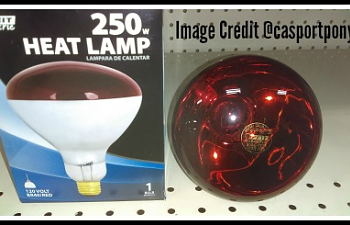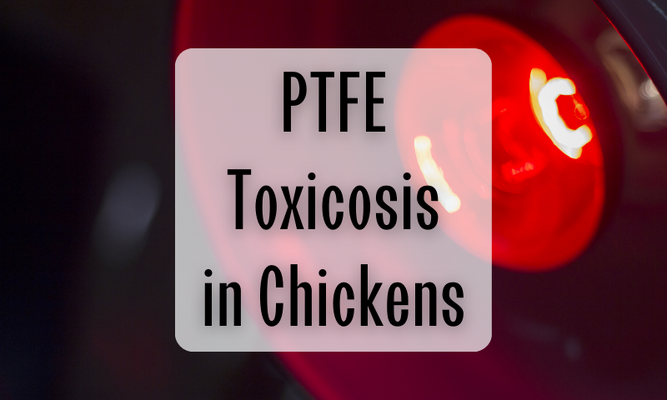What is PTFE? How can it harm my chickens?
Polytetrafluoroethylene or PTFE is often known by the brand name Teflon™. It is a synthetic polymer often used as a non-stick coating for cookware or shatter-resistant heat lamps. Though intended for use in the food industry, poultry owners may accidentally acquire these heat lamps, putting their flock in danger.
When heated, PTFE begins to break down and release toxic particles and gases. These products may cause flu-like symptoms in humans that resolve when the source is removed. However, birds have a respiratory system 10 times more efficient than a mammal's respiratory system [1] and will die after minimal levels of exposure.
I thought PTFE was inert. When does it become dangerous?
PTFE breaks down when heated, as do most plastics. Technical data sheets as well as the official guidance for Teflon™ products state a continuous use limit of 500°F or 260°C. [2] Decomposition begins in earnest at 535°F or 280°C, releasing gases and particulates that will kill birds in under 4 hours. [3] However, avian deaths are documented from temperatures as low as 324°F or 162°C. [4] A 250 watt heat lamp can reach a surface temperature of at least 260°C or 500°F which is enough to place it in the danger zone for decomposition.
As PTFE heats, the first product is resin dust. It is classified as a nuisance dust, but it is capable of causing respiratory symptoms and possibly death in birds. [3] At the lower to middle end of PTFE’s thermal decomposition range, the main cause of death and injury are ultra fine particulates or UFPs. These particles are associated with bleeding in the lungs visible upon necropsy. As the temperature rises, gas-phase products become the primary cause of toxicity. Interestingly, one study on rats (Johnston et al. 2000) shows that while the gas-phase products of PTFE decomposition at low temperatures were not concentrated enough to cause death or injury, combining them with UFPs resulted in fatalities. Similarly, UFPs by themselves had no effect. [5] One theory proposed to explain this is that the UFPs may serve as a carrier mechanism for the gas-phase products.
At higher temperatures, shown in Figure 1, more gas-phase compounds are produced. Three of the compounds produced are tetrafluoroethylene (TFE), hexafluoropropene (HFP), and perfluoroisobutylene (PFIB). All of these compounds have negative health effects and will cause respiratory injury or death.
Figure 1: excerpts of PTFE decomposition products at different temperatures. Chart concepts and data sourced from Waritz (1975). [3]
Image created in Canva
While many of these studies were conducted at very high temperatures, unlikely to occur in a backyard poultry setup, it should be stressed that these decomposition products occur in ranges and not firm cutoffs. The unique sensitivity of the avian respiratory system means that there is no safe level of exposure to the products of heated PTFE. Any exposure puts your flock at risk.
What are the symptoms of PTFE toxicosis?
Respiratory distress and death are the first visible symptoms. Live birds will have trouble breathing, balance problems, and may act upset or restless. [6] With sufficient exposure, there is a very short window of time between onset of symptoms and death. Necropsy of a dead bird will show bleeding and fluid in the lungs. Other respiratory toxins or illnesses may cause similar symptoms, so the bird’s environment must be evaluated before a conclusive diagnosis is made.
Always have an avian vet perform a necropsy if your flock has multiple sudden fatalities.
Can I treat survivors?
In a clinical setting, birds may be given oxygen, diuretics, and antibiotics. [6] Unfortunately, recovery is not likely, and often the bird will die within a day. Even for survivors, euthanasia may be the kinder choice as the resulting respiratory problems will not resolve.
If your birds seem like they may be affected by PTFE or another airborne toxin, move them to fresh air immediately. Keep them warm and calm, and bring them to an avian vet as soon as possible. Survival depends on how big the bird is, how concentrated the PTFE products are in the air, and how long it spends in the toxic environment.
How can I prevent this from happening?
Check the labels on the packaging of every heat-related product you use around your birds. Heat lamps, hair dryers, heating pads, cookware, and space heaters may contain PTFE. Most backyard poultry are likely to be exposed through heat lamps, which are commonly used for young birds in brooders or in outdoor coops to compensate for winter temperatures. Any bulbs labelled “shatter-resistant” or appearing opaque or hazy should not be used, even if they do not declare PTFE on the packaging. Never use non-stick or Teflon™ cookware around birds. If you bring a sick or young bird inside, do not allow them in the kitchen.
Heating pads, despite potentially containing PTFE, have not been linked to any fatalities and are frequently used by BYC members to raise chicks. They stay much cooler than heat lamps, around 110°F or 43°C on low, and are unlikely to cause breathing problems. Steps that can help keep heating pads safe include proper ventilation, replacing old or faulty products, and keeping the heat low.
Examples of Safe and Unsafe Heat Lamps

Figure 2: safe heating lamps. Photo credits @BantyChooks @casportpony @oldhenlikesdogs
Image created in Canva

Figure 3: unsafe heating lamps. Photo credit @BantyChooks
Image created in Canva
Note the hazy, rough texture of the PTFE-coated bulb. When in doubt, look for a bulb marketed for use with poultry and check the label carefully for any warnings.Figure 2: safe heating lamps. Photo credits @BantyChooks @casportpony @oldhenlikesdogs
Image created in Canva
Figure 3: unsafe heating lamps. Photo credit @BantyChooks
Image created in Canva
Records of PTFE-Related Incidents
- 52% of a large broiler flock at a research facility died over several days. Symptoms and necropsy suggested exposure to some sort of toxic gas. The only changes that had been made recently were the addition of 48 PTFE-coated heat lamps. No other gases were found in their housing that could explain the necropsy findings. [7]
- A member here on BYC had all but one of her flock members die after accidentally using a PTFE-coated heat lamp. See post #75. Seven dead hens within 4 hours, not attacked. UPDATE: Teflon Poisoning!
- The website ewg.org has kept an extensive log of indoor bird deaths stemming from PTFE coated objects and the circumstances surrounding the incidents.
- A group of chicks in a research facility had many deaths within a short period of time. The cause was determined to be the new shatter-proof heat lamps. [8]
Appendix: The Avian Respiratory System
http://www2.ca.uky.edu/agcomm/pubs/ASC/ASC200/ASC200.pdf
https://articles.extension.org/pages/65375/avian-respiratory-system
Sources
[1]O'Malley, B. (2008). Clinical anatomy and physiology of avian species-from bird brains to pigeon toes.
[2]
Teflon.com, n.d. Properties of Teflon Industrial Coatings. Retrieved October 2024.
[3]
Waritz, R.S. (1975). An Industrial Approach to Evaluation of Pyrolysis and Combustion Hazards.
[4]
Sajid, M. and Ilyas, M. (2017). PTFE-coated non-stick cookware and toxicity concerns: a perspective.
[5]
Johnston, C. et al. (2000). Pulmonary Effects Induced by Ultrafine PTFE Particles.
[6]
Richardson, J.A. (2010). Implication of Toxic Substances in Clinical Disorders.
[7]
Boucher, M. (1999). Polytetrafluoroethylene Gas Intoxication in Broiler Chickens.
[8]
Shuster, K.A. et al. (2012). Polytetrafluoroethylene Toxicosis in Recently Hatched Chickens (Gallus domesticus).










